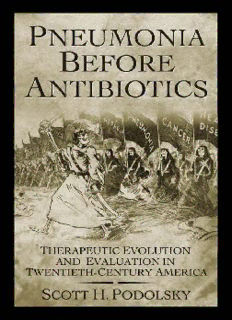
Pneumonia Before Antibiotics: Therapeutic Evolution and Evaluation in Twentieth-Century America PDF
Preview Pneumonia Before Antibiotics: Therapeutic Evolution and Evaluation in Twentieth-Century America
Pneumonia Before Antibiotics This page intentionally left blank Pneumonia Before Antibiotics Therapeutic Evolution and Evaluation in Twentieth-Century America scott h. podolsky The Johns Hopkins University Press Baltimore © 2006 The Johns Hopkins University Press All rights reserved. Published 2006 Printed in the United States of America on acid-free paper 2 4 6 8 9 7 5 3 1 The Johns Hopkins University Press 2715 North Charles Street Baltimore, Maryland 21218-4363 www.press.jhu.edu Library of Congress Cataloging-in-Publication Data Podolsky, Scott H. Pneumonia before antibiotics : therapeutic evolution and evaluation in twentieth-century America / Scott H. Podolsky. p. ; cm. Includes bibliographical references and index. isbn0-8018-8327-X (hardcover : alk. paper) 1. Pneumonia, Pneumococcal—United States—History—2oth century. 2. Pneumonia, Pneumococcal—Treatment—United States—History—2oth century. 3. Pneumonia, Pneumococcal—Chemotherapy—United States— History—2oth century. 4. Serotherapy—United States—History—2oth century. I. Title. [DNLM. 1. Pneumonia, Pneumococcal—history—United States. 2. Drug Therapy—history—United States. 3. History, 20th century—United States. 4. Immunization, Passive—history—United States. 5. Pneumonia, Pneumococcal—therapy—United States. WC 204 p742p 2006] rc771.p72 2006 362.196(cid:1)241—dc22 A catalog record for this book is available from the British Library. For Josh and Danny This page intentionally left blank contents Acknowledgments ix Introduction: Patterns of Resistance 1 part i serotherapy and the rise of the specific, 1891–1930 9 1 The Advent of Type-Specific Antipneumococcal Serotherapy 13 2 A “Specific” Specific and the Turbid Age of Applied Immunology 22 3 Fundamental Tensions: Clinical “Proof” and Clinical Resistance 35 part ii. the transformation of pneumonia into a public health concern, 1930–1939 51 4 The Massachusetts Experiment and New (York) Tensions 53 5 The New Standard, the New Deal, and the Pneumonia Control Programs 68 viii Contents part iii resolution: the antimicrobial “revolution” and the decline of serotherapy, 1939–present 89 6 Histology of a Revolution 91 7 A “Modern” Revolution: The Limits and Uses of Controlled Clinical Trials 115 8 The Dismantling of Pneumonia as a Public Health Concern 132 Conclusion: Overcoming Resistance 147 Notes 151 Index 247 acknowledgments Beyond having a substantial impact on my clinical practice and thinking, re- searching and writing the history of medicine is simply fun (to echo Sherwin Nu- land). Being able to thank those who have made this possible is perhaps even more fun. I have been fortunate to have had mentors who have challenged me at the same time that they permitted me the freedom to dive in and challenge myself. Fred Tauber first supported my over-enthusiastic tendencies with respect to the history of science and medicine and continues to see through the trees and en- able me to focus on the most pertinent questions at hand. Allan Brandt has shown me how to approach medicine as inherently social and has served as a role model as both teacher and historian. Two colleagues in particular—Jeremy Greene and David Jones—not only fur- ther taught me how to teach, but provided crucial feedback on the project throughout its development. In addition to my mentors and colleagues named above, Stephen Kandel, Calvin Kunin, Jennifer Rochow, and Peter Tishler worked their way through the entire manuscript, o¤ering both insights and corrections. Jack Lesch and Nick Rasmussen generously read and commented on particular chapters. Wolfram Goessling provided expert assistance with the nineteenth- century German literature. Harry Marks provided the opportunity to present my work at Johns Hopkins, and I am grateful for the feedback provided by him and Ed Mormon, in particular. I have always thought of this manuscript as continu- ing a dialogue started by two Harry’s—Dowling and Marks—and inspired by their e¤orts and aided by their leads, I can only hope to have approached the rigor of their own work. One of the great joys I have been exposed to has been that of the translocative experience of intense archival research. I am particularly grateful to the sta¤s of the Countway Medical Library here at Harvard (and its Center for the History of
Description: